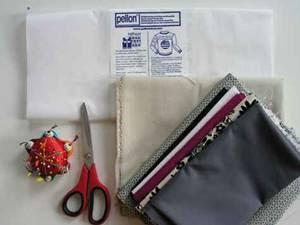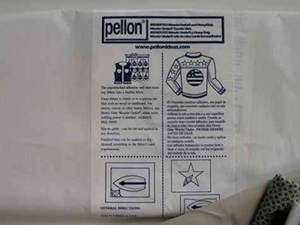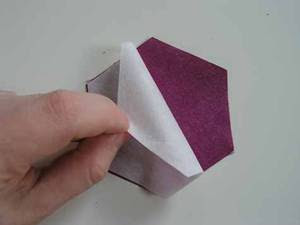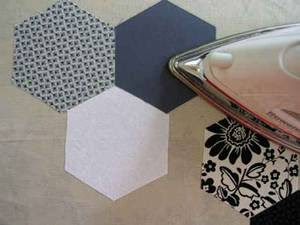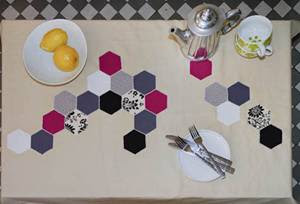For beginners Sewing, it’s best pattern review to start with free simple shapes with straight lines modern but once you get beginner the hang of download sewing patterns easy technique, you can appliqué just about any shape. Think monograms, floral or animal silhouettes, or even images cut from patterned fabric. The sky’s the limit and this really is the easiest thing in the world, so let’s get started! -Brett
What You’ll Need
A variety of coordinating fabrics for the appliqué
Background fabric
Fusible webbing (a popular brand is Pellon)
Sharp scissors
Straight pins
Sewing machine
Iron
1. Prepare your template
To start, you’ll make a template of the shape you want to use, and cut it from fusible webbing. Fusible webbing is a whisper thin, web-like sheet that has adhesive on both sides which is activated with a hot iron. Check the packaging of the webbing you purchase for instructions on how to apply your specific brand; generally there is a paper backing on one or both sides of the webbing which you peel off to expose the adhesive.
Choose a shape for your appliqué — for beginners, simple shapes and straight lines are the way to go. I chose hexagons because I love the look of quilted hexes, but applying them the real way (ie, sewn on by hand) is dauntingly labor intensive!
Simple trace your desired shape onto the paper backing of the fusible webbing, and cut it out.
2. Transfer the cut-out webbing to your fabric
Place your cut-out piece of fusible webbing on the wrong side of your fabric, with the paper side of the webbing facing up (again, check your packaging here for brand-specific instructions). Iron over the paper backing to adhere the webbing to the fabric (the paper will stick to the fabric too, but that will come off later).
3. Cut out the shape
Cut the fabric around the perimeter of the paper, then peel off the paper backing. It can be tricky to un-stick the paper from the fabric, so I sometimes use tweezers to grab the paper and separate it from the fabric.
After you remove the paper, there will be a nearly-invisible layer of adhesive remaining on the fabric.
4. Fuse the cut-out shapes to the background fabric
Next, determine where you’d like to place your shapes on your background fabric, and position them right-side up on the right side of the background fabric. Iron them in place, and voila! The fabrics will be neatly fused together.
5. Stitch around the edges
To prevent the edges of the fabric from fraying, sew a zig-zag line of stitching around each raw edge. Play around with your machine’s stitch settings, varying the width of the zig-zag and the stitch length, until you have a zig-zag that’s the width you like and with a short stitch length so that the stitching will be nearly solid.
Center the stitch over the outer edge of the cut-out piece, and simply sew around the perimeter of each piece.
If you have two pieces of appliqué touching each other, sew along the border where they meet. The goal is to cover every raw edge with stitching.
6. Press
When you’re done, don’t be dismayed if your stitching looks puckered.
Just hit it with a steam iron, and it will smooth right out!
Resources
Sewing
Pattern
home sewing simple tutorials techniques
What You’ll Need
A variety of coordinating fabrics for the appliqué
Background fabric
Fusible webbing (a popular brand is Pellon)
Sharp scissors
Straight pins
Sewing machine
Iron
1. Prepare your template
To start, you’ll make a template of the shape you want to use, and cut it from fusible webbing. Fusible webbing is a whisper thin, web-like sheet that has adhesive on both sides which is activated with a hot iron. Check the packaging of the webbing you purchase for instructions on how to apply your specific brand; generally there is a paper backing on one or both sides of the webbing which you peel off to expose the adhesive.
Choose a shape for your appliqué — for beginners, simple shapes and straight lines are the way to go. I chose hexagons because I love the look of quilted hexes, but applying them the real way (ie, sewn on by hand) is dauntingly labor intensive!
Simple trace your desired shape onto the paper backing of the fusible webbing, and cut it out.
2. Transfer the cut-out webbing to your fabric
Place your cut-out piece of fusible webbing on the wrong side of your fabric, with the paper side of the webbing facing up (again, check your packaging here for brand-specific instructions). Iron over the paper backing to adhere the webbing to the fabric (the paper will stick to the fabric too, but that will come off later).
3. Cut out the shape
Cut the fabric around the perimeter of the paper, then peel off the paper backing. It can be tricky to un-stick the paper from the fabric, so I sometimes use tweezers to grab the paper and separate it from the fabric.
After you remove the paper, there will be a nearly-invisible layer of adhesive remaining on the fabric.
4. Fuse the cut-out shapes to the background fabric
Next, determine where you’d like to place your shapes on your background fabric, and position them right-side up on the right side of the background fabric. Iron them in place, and voila! The fabrics will be neatly fused together.
5. Stitch around the edges
To prevent the edges of the fabric from fraying, sew a zig-zag line of stitching around each raw edge. Play around with your machine’s stitch settings, varying the width of the zig-zag and the stitch length, until you have a zig-zag that’s the width you like and with a short stitch length so that the stitching will be nearly solid.
Center the stitch over the outer edge of the cut-out piece, and simply sew around the perimeter of each piece.
If you have two pieces of appliqué touching each other, sew along the border where they meet. The goal is to cover every raw edge with stitching.
6. Press
When you’re done, don’t be dismayed if your stitching looks puckered.
Just hit it with a steam iron, and it will smooth right out!
Resources
Sewing
Pattern
home sewing simple tutorials techniques

